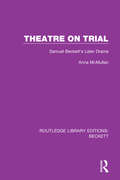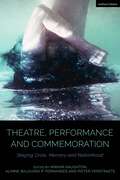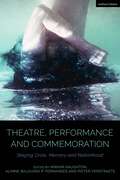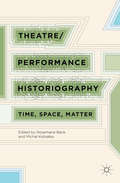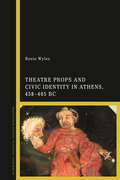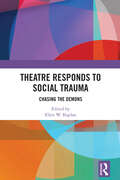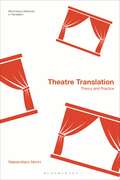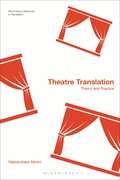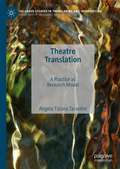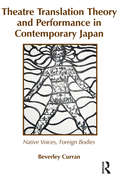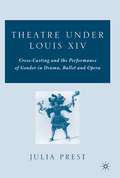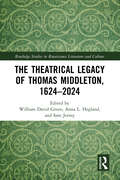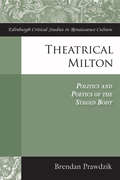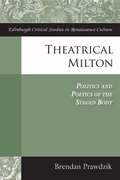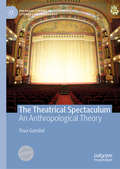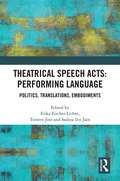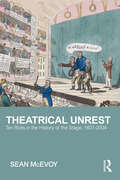- Table View
- List View
Theatre on Trial: Samuel Beckett's Later Drama (Routledge Library Editions: Beckett #5)
by Anna McMullanThis book, first published in 1993, is the first full-length analysis of Samuel Beckett’s later drama in the context of contemporary critical and performance theory. It employs a close, textual examination of the later plays as a springboard for exploring ideas around authority, gender and the ideology of performance. Recent work in the world of critical theory has suggested new ways of looking at performance practice. McMullan argues that, while contemporary theory can deepen our understanding of Beckett’s dramatic practice, his drama places performance in the context of a metaphysical history and a metatheatrical tradition, thereby confronting and provoking some of the central debates in performance studies’ engagement with critical theory.
Theatre on Trial: Samuel Beckett's Later Drama (Routledge Library Editions: Beckett #5)
by Anna McMullanThis book, first published in 1993, is the first full-length analysis of Samuel Beckett’s later drama in the context of contemporary critical and performance theory. It employs a close, textual examination of the later plays as a springboard for exploring ideas around authority, gender and the ideology of performance. Recent work in the world of critical theory has suggested new ways of looking at performance practice. McMullan argues that, while contemporary theory can deepen our understanding of Beckett’s dramatic practice, his drama places performance in the context of a metaphysical history and a metatheatrical tradition, thereby confronting and provoking some of the central debates in performance studies’ engagement with critical theory.
Theatre, Performance and Commemoration: Staging Crisis, Memory and Nationhood (Cultural Histories of Theatre and Performance)
by Claire Cochrane Bruce McConachieHow does the act of performance speak to the concept of commemoration? How and why does commemorative theatre operate as a conceptual, historical and political site from which to interrogate ideas of nationalism and nationhood? This volume explores how theatre and performance create a stage for acts of commemoration, considering crises of hate, nationalism and migration, as well as political, racial and religious bigotry. It features case studies drawn from across Europe, the Middle East, Asia, Africa and Latin America. The book's four parts each explore commemoration through a different theoretical lens and present a new set of dramaturgies for research and study. While Section 1 offers a critical survey of 20th- and 21st-century discourses, Section 2 uncovers the commemorative practices underpinning contemporary dramaturgy and applies these practices to plays and performance pieces. These include works by Martin Lynch, Frank McGuinness, Sanja Mitrovic, Theater RAST, Les SlovaKs Dance Collective, Estela Golovchenko, Wajdi Mouawad, Áine Stapleton, CoisCéim, ANU Productions, Aubrey Sekhabi, and Indian and African dance practices. The final sections investigate how individual and collective memory and performances of commemoration can become tools for propaganda and political agendas.
Theatre, Performance and Commemoration: Staging Crisis, Memory and Nationhood (Cultural Histories of Theatre and Performance)
by Claire Cochrane Bruce McConachieHow does the act of performance speak to the concept of commemoration? How and why does commemorative theatre operate as a conceptual, historical and political site from which to interrogate ideas of nationalism and nationhood? This volume explores how theatre and performance create a stage for acts of commemoration, considering crises of hate, nationalism and migration, as well as political, racial and religious bigotry. It features case studies drawn from across Europe, the Middle East, Asia, Africa and Latin America. The book's four parts each explore commemoration through a different theoretical lens and present a new set of dramaturgies for research and study. While Section 1 offers a critical survey of 20th- and 21st-century discourses, Section 2 uncovers the commemorative practices underpinning contemporary dramaturgy and applies these practices to plays and performance pieces. These include works by Martin Lynch, Frank McGuinness, Sanja Mitrovic, Theater RAST, Les SlovaKs Dance Collective, Estela Golovchenko, Wajdi Mouawad, Áine Stapleton, CoisCéim, ANU Productions, Aubrey Sekhabi, and Indian and African dance practices. The final sections investigate how individual and collective memory and performances of commemoration can become tools for propaganda and political agendas.
Theatre/Performance Historiography: Time, Space, Matter
by Michal Kobialka Rosemarie K. BankHow do the ethical implications of writing theatrical histories complicate the historiographical imperative in our current sociopolitical context? This volume investigates a historiography whose function is to be a mode of thinking and exposes the inner contradictions in social and ideological organizations of historical subjects.
Theatre Props and Civic Identity in Athens, 458-405 BC
by Rosie WylesThis book answers the question 'How did Athenian drama shape ideas about civic identity?' through the medium of three case studies focusing on props. Traditional responses to the question have overlooked the significance of props which were symbolically implicated in Athenian ideology, yet the key objects explored in this study (voting urns and pebbles, swords, and masks) each carried profound connections to Athenian civic identity while also playing important roles as props on the fifth-century stage. Playwrights exploited the powerful dynamic generated from the intersection between the 'social lives' (off-stage existence in society) and 'stage lives' (handling in theatre) of these objects to enhance the dramatic effect of their plays as well as the impact of these performances on society.The exploration of the 'stage lives' of these objects across comedy, tragedy, and satyr drama reveals much about generic interdependence and distinction. Meanwhile the consideration of iconography representing the objects' lives outside the theatre sheds light on drama's powerful interplay with art. Essential reading for scholars and students of ancient Greek history, culture, and drama, the innovative approach and insightful analysis contained in this volume will also be of interest to researchers in the fields of Theatre Studies, Art History, and Cultural Studies.
Theatre Props and Civic Identity in Athens, 458-405 BC
by Rosie WylesThis book answers the question 'How did Athenian drama shape ideas about civic identity?' through the medium of three case studies focusing on props. Traditional responses to the question have overlooked the significance of props which were symbolically implicated in Athenian ideology, yet the key objects explored in this study (voting urns and pebbles, swords, and masks) each carried profound connections to Athenian civic identity while also playing important roles as props on the fifth-century stage. Playwrights exploited the powerful dynamic generated from the intersection between the 'social lives' (off-stage existence in society) and 'stage lives' (handling in theatre) of these objects to enhance the dramatic effect of their plays as well as the impact of these performances on society.The exploration of the 'stage lives' of these objects across comedy, tragedy, and satyr drama reveals much about generic interdependence and distinction. Meanwhile the consideration of iconography representing the objects' lives outside the theatre sheds light on drama's powerful interplay with art. Essential reading for scholars and students of ancient Greek history, culture, and drama, the innovative approach and insightful analysis contained in this volume will also be of interest to researchers in the fields of Theatre Studies, Art History, and Cultural Studies.
Theatre Responds to Social Trauma: Chasing the Demons (Routledge Series in Equity, Diversity, and Inclusion in Theatre and Performance)
by Ellen W. KaplanThis book is a collection of chapters by playwrights, directors, devisers, scholars, and educators whose praxis involves representing, theorizing, and performing social trauma.Chapters explore how psychic catastrophes and ruptures are often embedded in social systems of oppression and forged in zones of conflict within and across national borders. Through multiple lenses and diverse approaches, the authors examine the connections between collective trauma, social identity, and personal struggle. We look at the generational transmission of trauma, socially induced pathologies, and societal re-inscriptions of trauma, from mass incarceration to war-induced psychoses, from gendered violence through racist practices. Collective trauma may shape, protect, and preserve group identity, promoting a sense of cohesion and meaning, even as it shakes individuals through pain. Engaging with communities under significant stress through artistic practice offers a path towards reconstructing the meaning(s) of social trauma, making sense of the past, understanding the present, and re-visioning the future.The chapters combine theoretical and practical work, exploring the conceptual foundations and the artists’ processes as they interrogate the intersections of personal grief and communal mourning, through drama, poetry, and embodied performance.
Theatre Responds to Social Trauma: Chasing the Demons (Routledge Series in Equity, Diversity, and Inclusion in Theatre and Performance)
This book is a collection of chapters by playwrights, directors, devisers, scholars, and educators whose praxis involves representing, theorizing, and performing social trauma.Chapters explore how psychic catastrophes and ruptures are often embedded in social systems of oppression and forged in zones of conflict within and across national borders. Through multiple lenses and diverse approaches, the authors examine the connections between collective trauma, social identity, and personal struggle. We look at the generational transmission of trauma, socially induced pathologies, and societal re-inscriptions of trauma, from mass incarceration to war-induced psychoses, from gendered violence through racist practices. Collective trauma may shape, protect, and preserve group identity, promoting a sense of cohesion and meaning, even as it shakes individuals through pain. Engaging with communities under significant stress through artistic practice offers a path towards reconstructing the meaning(s) of social trauma, making sense of the past, understanding the present, and re-visioning the future.The chapters combine theoretical and practical work, exploring the conceptual foundations and the artists’ processes as they interrogate the intersections of personal grief and communal mourning, through drama, poetry, and embodied performance.
Theatre Sciences: A Plea for a Multidisciplinary Approach to Theatre Studies
by Eli RozikTraditional theatre semiotics promoted a scientific approach to theatre studies, albeit viewing semiotics as the unique discipline of research. Theatre Sciences: A Plea for a Multidisciplinary Approach to Theatre Studies suggests instead a multi-disciplinary approach, including the following theoretical disciplines: narratology, mythology, pragmatics, ethics, theatre irony, theory of genres, aesthetics, semiotics, theory of non-verbal figures of speech, rhetoric, psychoanalysis, reception theory, history, and sociology -- with semiotics being only one among equals. These disciplines are presented from the perspective of their possible contributions to a sound methodology of theatre-texts analysis. Traditional theatre semiotics, moreover, holds the view that the actual performance on stage is the genuine text of theatre, instead of the play-script. Despite this paradigmatic shift, however, this viewpoint has failed to produce commendable analyses of such texts. The alternative presupposition put forward in this volume entails a series of novel perceptions of the theatre-text and its possible impact on the experiencing spectator, whose role in reading, interpreting and experiencing the theatre-text is not less crucial than that of the text itself. This view presupposes that the theatre-text is a description of a fictional world generated by the theatre medium. The author also contests the age-old view that a theatre/fictional-text reflects a simple narrative structure, and suggests instead a complexity that consists of seven layers: personified, mythical, praxical, naive, ironic, modal and aesthetic -- with each one of them re-structuring the previous layer. Professor Rozik also presents and describes a semiotic layer that lends communicative capacity to the description of a fictional world, and two additional metaphoric and rhetoric layers, which structure the theatre experience. The underlying purpose is to illustrate the application of the aforementioned disciplines to these fictional layers, and eventually their joint application to entire theatre / fictional texts. Organisation of the book reflects the structure of a university course.
Theatre Translation: Theory and Practice (Bloomsbury Advances in Translation)
by Massimiliano MoriniTranslation for the theatre is often considered to hold a marginal status between literary translation and adaptation for the stage. As a result, this book argues that studies of this complex activity tend to take either a textual or performative approach. After exploring the history of translation theory through these lenses, Massimiliano Morini proposes a more totalizing view of 'theatre translation' as the sum of operations required to transform one theatre act into another, and analyses three complex Western case histories in light of this all-encompassing definition. Combining theory with practice, Morini investigates how traditional ideas on translation – from Plautus and Cicero to the early 20th century – have been applied in the theatrical domain. He then compares and contrasts the inherently textual viewpoint of post-humanistic translators with the more performative approaches of contemporary theatrical practitioners, and chronicles the rise of performative views in the third millennium. Positioning itself at the intersection of past and present, as well as translation studies and theatre semiotics, Theatre Translation provides a full diachronic survey of an age-old activity and a burgeoning academic field.
Theatre Translation: Theory and Practice (Bloomsbury Advances in Translation)
by Massimiliano MoriniTranslation for the theatre is often considered to hold a marginal status between literary translation and adaptation for the stage. As a result, this book argues that studies of this complex activity tend to take either a textual or performative approach. After exploring the history of translation theory through these lenses, Massimiliano Morini proposes a more totalizing view of 'theatre translation' as the sum of operations required to transform one theatre act into another, and analyses three complex Western case histories in light of this all-encompassing definition. Combining theory with practice, Morini investigates how traditional ideas on translation – from Plautus and Cicero to the early 20th century – have been applied in the theatrical domain. He then compares and contrasts the inherently textual viewpoint of post-humanistic translators with the more performative approaches of contemporary theatrical practitioners, and chronicles the rise of performative views in the third millennium. Positioning itself at the intersection of past and present, as well as translation studies and theatre semiotics, Theatre Translation provides a full diachronic survey of an age-old activity and a burgeoning academic field.
Theatre Translation: A Practice as Research Model (Palgrave Studies in Translating and Interpreting)
by Angela Tiziana TarantiniThis book examines the effects of translation on theatrical performance. The author adapts and applies Kershaw et al.’s Practice as Research model to an empirical investigation analysing the effects of translation on the rhythm and gesture of a playtext in performance, using the contemporary plays Convincing Ground and The Gully by Australian playwright David Mence which have been translated into Italian. The book is divided into two parts: a theoretical exegesis encompassing Translation Studies, Performance Studies and Gesture Studies, and a practical investigation comprising of a workshop where excerpts of the plays are explored by two groups of actors. The chapters are accompanied by short clips of the performance workshop hosted on SpringerLink. The book will be of interest to students and scholars in the fields of Translation Studies (and Theatre Translation more specifically), Theatre and Performance, and Gesture Studies.
Theatre Translation Theory and Performance in Contemporary Japan: Native Voices Foreign Bodies
by Beverley CurranWhat motivates a Japanese translator and theatre company to translate and perform a play about racial discrimination in the American South? What happens to a 'gay' play when it is staged in a country where the performance of gender is a theatrical tradition? What are the politics of First Nations or Aboriginal theatre in Japanese translation and 'colour blind' casting? Is a Canadian nô drama that tells a story of the Japanese diaspora a performance in cultural appropriation or dramatic innovation? In looking for answers to these questions, Theatre Translation Theory and Performance in Contemporary Japan extends discussions of theatre translation through a selective investigation of six Western plays, translated and staged in Japan since the 1960s, with marginalized tongues and bodies at their core. The study begins with an examination of James Baldwin's Blues for Mister Charlie, followed by explorations of Michel Marc Bouchard's Les feluettes ou La repetition d'un drame romantique, Tomson Highway's The Rez Sisters and Dry Lips Oughta Move to Kapuskasing, Roger Bennett's Up the Ladder, and Daphne Marlatt's The Gull: The Steveston t Noh Project. Native Voices, Foreign Bodies locates theatre translation theory and practice in Japan in the post-war Showa and Heisei eras and provokes reconsideration of Western notions about the complex interaction of tongues and bodies in translation and theatre when they travel and are reconstituted under different cultural conditions.
Theatre Translation Theory and Performance in Contemporary Japan: Native Voices Foreign Bodies
by Beverley CurranWhat motivates a Japanese translator and theatre company to translate and perform a play about racial discrimination in the American South? What happens to a 'gay' play when it is staged in a country where the performance of gender is a theatrical tradition? What are the politics of First Nations or Aboriginal theatre in Japanese translation and 'colour blind' casting? Is a Canadian nô drama that tells a story of the Japanese diaspora a performance in cultural appropriation or dramatic innovation? In looking for answers to these questions, Theatre Translation Theory and Performance in Contemporary Japan extends discussions of theatre translation through a selective investigation of six Western plays, translated and staged in Japan since the 1960s, with marginalized tongues and bodies at their core. The study begins with an examination of James Baldwin's Blues for Mister Charlie, followed by explorations of Michel Marc Bouchard's Les feluettes ou La repetition d'un drame romantique, Tomson Highway's The Rez Sisters and Dry Lips Oughta Move to Kapuskasing, Roger Bennett's Up the Ladder, and Daphne Marlatt's The Gull: The Steveston t Noh Project. Native Voices, Foreign Bodies locates theatre translation theory and practice in Japan in the post-war Showa and Heisei eras and provokes reconsideration of Western notions about the complex interaction of tongues and bodies in translation and theatre when they travel and are reconstituted under different cultural conditions.
Theatre Under Louis XIV: Cross-Casting and the Performance of Gender in Drama, Ballet and Opera
by J. PrestThis book explores the fascinating phenomenon of cross-casting and related gender issues in different theatrical genres and different performance contexts during the heyday of French theatre. Although professional acting troupes under Louis XIV were mixed, cross-casting remained an important feature of French court ballet (in which the King himself performed a number of women's roles) and an occasional feature of spoken comedy and tragic opera. Cross-casting also persisted out of necessity in the school drama of the period. This book fills an important gap in the history of French theatre and provides new insight into wider theoretical questions of gender and theatricality. The inclusion of chapters on ballet and opera (as well as spoken drama) opens up the richness of French theatre under Louis XIV in a way that has not been achieved before.
The Theatrical Legacy of Thomas Middleton, 1624–2024 (Routledge Studies in Renaissance Literature and Culture)
by William David Green Anna L. Hegland Sam JermyThis volume celebrates Thomas Middleton’s legacy as a dramatist, marking the 400th anniversary of Middleton’s final and most contentious work for the public theatres, A Game at Chess (1624).The collection is divided into three sections: ‘Critical and Textual Reception’, ‘Afterlives and Legacies’, and ‘Practice and Performance’. This division reflects the book’s holistic approach to Middleton’s canon, and its emphasis on the continuing significance of Middleton’s writing to the study of early modern English drama. Each section offers an assessment of the place of Middleton’s drama in culture, criticism, and education today through a range of critical approaches.Featuring work from a range of voices (from early career, independent, and seasoned academics and practitioners), the collection will be appropriate for both specialists in early modern literature and drama who are interested in both theory and practice, and students or scholars researching Middleton’s historical significance to the study of early theatre.
The Theatrical Legacy of Thomas Middleton, 1624–2024 (Routledge Studies in Renaissance Literature and Culture)
This volume celebrates Thomas Middleton’s legacy as a dramatist, marking the 400th anniversary of Middleton’s final and most contentious work for the public theatres, A Game at Chess (1624).The collection is divided into three sections: ‘Critical and Textual Reception’, ‘Afterlives and Legacies’, and ‘Practice and Performance’. This division reflects the book’s holistic approach to Middleton’s canon, and its emphasis on the continuing significance of Middleton’s writing to the study of early modern English drama. Each section offers an assessment of the place of Middleton’s drama in culture, criticism, and education today through a range of critical approaches.Featuring work from a range of voices (from early career, independent, and seasoned academics and practitioners), the collection will be appropriate for both specialists in early modern literature and drama who are interested in both theory and practice, and students or scholars researching Middleton’s historical significance to the study of early theatre.
Theatrical Milton: Politics and Poetics of the Staged Body (Edinburgh Critical Studies in Renaissance Culture)
by Brendan PrawdzikTheatrical Milton brings coherence to the presence of theatre in John Milton through the concept of theatricality. In this book, ‘theatricality’ identifies a discursive field entailing the rhetorical strategies and effects of framing a given human action, including speech and writing, as an act of theatre. Political and theological cultures in seventeenth-century England developed a treasury of representational resources in order to stage—to satirize and, above all, to de-legitimate—rhetors of politics, religion, and print. At the core of Milton’s works is a contradictory relation to theatre that has neither been explained nor properly explored. This book changes the terms of scholarly discussion and discovers how the social structures of theatre afforded Milton resources for poetic and polemical representation and uncovers the precise contours of Milton’s interest in theatre and drama.
Theatrical Milton: Politics and Poetics of the Staged Body (Edinburgh Critical Studies in Renaissance Culture)
by Brendan PrawdzikTheatrical Milton brings coherence to the presence of theatre in John Milton through the concept of theatricality. In this book, ‘theatricality’ identifies a discursive field entailing the rhetorical strategies and effects of framing a given human action, including speech and writing, as an act of theatre. Political and theological cultures in seventeenth-century England developed a treasury of representational resources in order to stage—to satirize and, above all, to de-legitimate—rhetors of politics, religion, and print. At the core of Milton’s works is a contradictory relation to theatre that has neither been explained nor properly explored. This book changes the terms of scholarly discussion and discovers how the social structures of theatre afforded Milton resources for poetic and polemical representation and uncovers the precise contours of Milton’s interest in theatre and drama.
The Theatrical Spectaculum: An Anthropological Theory (Palgrave Studies in Literary Anthropology)
by Tova GamlielThis book offers a new mythic perspective on the secret of the allure and survival of a current-archaic institution—the Western theatre—in an era of diverse technological media. Central to the theory is the spectaculum—a stage “world” that mirrors a monotheistic cosmic order. Tova Gamliel here not only alerts the reader to the possibility of the spectaculum’s existence, but also illuminates its various structural dimensions: the cosmological, ritual, and sociological. Its cosmo-logical meaning is a Judeo-Christian monotheistic consciousness of non-randomness, an exemplary order of the world that the senses perceive. The ritual meaning denotes the centrality of the spectaculum, as the theatre repeatedly reenacts the mythical and paradigmatic event of Biblical revelation. Its social meaning concerns any charismatic social theory that is anchored in the epitomic structure of social sovereignty—stage and audience—that the Western theatre advances in an era characterized by hypermedia.
Theatrical Speech Acts: Politics, Translations, Embodiments
by Erika Fischer-Lichte Torsten Jost Saskya Iris JainTheatrical Speech Acts: Performing Language explores the significance and impact of words in performance, probing how language functions in theatrical scenarios, what it can achieve under particular conditions, and what kinds of problems may arise as a result. Presenting case studies from around the globe—spanning Argentina, Egypt, Germany, India, Indonesia, Korea, Kenya, Nigeria, Rwanda, Thailand, the UK and the US—the authors explore key issues related to theatrical speech acts, such as (post)colonial language politics; histories, practices and theories of translation for/in performance; as well as practices and processes of embodiment. With scholars from different cultural and disciplinary backgrounds examining theatrical speech acts—their preconditions, their cultural and bodily dimensions as well as their manifold political effects—the book introduces readers to a crucial linguistic dimension of historical and contemporary processes of interweaving performance cultures. Ideal for drama, theater, performance, and translation scholars worldwide, Theatrical Speech Acts opens up a unique perspective on the transformative power of language in performance.
Theatrical Speech Acts: Politics, Translations, Embodiments
by Erika Fischer-Lichte Torsten Jost Saskya Iris JainTheatrical Speech Acts: Performing Language explores the significance and impact of words in performance, probing how language functions in theatrical scenarios, what it can achieve under particular conditions, and what kinds of problems may arise as a result. Presenting case studies from around the globe—spanning Argentina, Egypt, Germany, India, Indonesia, Korea, Kenya, Nigeria, Rwanda, Thailand, the UK and the US—the authors explore key issues related to theatrical speech acts, such as (post)colonial language politics; histories, practices and theories of translation for/in performance; as well as practices and processes of embodiment. With scholars from different cultural and disciplinary backgrounds examining theatrical speech acts—their preconditions, their cultural and bodily dimensions as well as their manifold political effects—the book introduces readers to a crucial linguistic dimension of historical and contemporary processes of interweaving performance cultures. Ideal for drama, theater, performance, and translation scholars worldwide, Theatrical Speech Acts opens up a unique perspective on the transformative power of language in performance.
Theatrical Unrest: Ten Riots in the History of the Stage, 1601-2004
by Sean McEvoyShortlisted for the 2017 Theatre Book Prize What is it about theatre, compared to other kinds of cultural representation, which provokes such a powerful reaction? Theatrical Unrest tells the compelling tales of ten riots whose cause lies on stage. It looks at the intensity and evanescence of the live event and asks whether theatre shares its unrepeatable quality with history. Tracing episodes of unrest in theatrical history from an Elizabethan uprising over Shakespeare's Richard II to Sikhs in revolt at Gurpreet Kaur Bhatti's Behzti, Sean McEvoy chronicles a selection of extreme public responses to this inflammatory art form. Each chapter provides a useful overview of the structure and documentation of one particular event, juxtaposing eyewitness accounts with newspaper reports and other contemporary narratives. Theatrical Unrest is an absorbing account of the explosive impact of performance, and an essential read for anyone interested in theatre’s often violent history.
Theatrical Unrest: Ten Riots in the History of the Stage, 1601-2004
by Sean McEvoyShortlisted for the 2017 Theatre Book Prize What is it about theatre, compared to other kinds of cultural representation, which provokes such a powerful reaction? Theatrical Unrest tells the compelling tales of ten riots whose cause lies on stage. It looks at the intensity and evanescence of the live event and asks whether theatre shares its unrepeatable quality with history. Tracing episodes of unrest in theatrical history from an Elizabethan uprising over Shakespeare's Richard II to Sikhs in revolt at Gurpreet Kaur Bhatti's Behzti, Sean McEvoy chronicles a selection of extreme public responses to this inflammatory art form. Each chapter provides a useful overview of the structure and documentation of one particular event, juxtaposing eyewitness accounts with newspaper reports and other contemporary narratives. Theatrical Unrest is an absorbing account of the explosive impact of performance, and an essential read for anyone interested in theatre’s often violent history.
